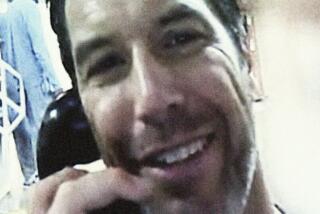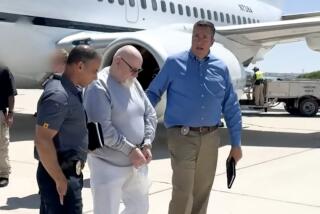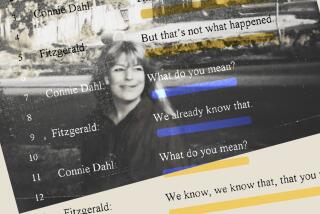Mothers of Victims Weep as Evidence Is Shown at Kraft Trial
- Share via
The mothers of two young men whom Randy Steven Kraft is accused of killing cried and hugged each other Monday after watching the first day of testimony about their sons’ deaths, including large-screen color photographs of one son’s nude body.
“It’s a driving force within you that makes you be there,” said Shirley DeVaul, one of the mothers, explaining why they sat through the gruesome details. “You just have to know what happened.”
The Kraft trial, which entered its second week of testimony Monday in Superior Court in Santa Ana, moved on to victims Geoffrey Alan Nelson, 18, and Rodger James DeVaul, 20, who were last seen in the Buena Park-Cypress area on Feb. 12, 1983.
Evidence on Marine’s Death
The first week was spent primarily on prosecution evidence in the murder of Terry Lee Gambrel, a 25-year-old El Toro Marine found dead in Kraft’s car when Kraft was arrested on May 14, 1983.
Gambrel, Nelson and DeVaul are among 16 Orange County victims that Kraft is charged with killing. The 43-year-old Long Beach computer consultant has denied killing anyone.
Nelson’s body was found early on Feb. 12, 1983, on the Euclid Street on-ramp to the westbound Garden Grove Freeway in Garden Grove. DeVaul’s body was found the next day in the Angeles National Forest in Los Angeles County.
It was Nelson’s body that was depicted in many of the blow-ups for jurors.
Before the pictures were shown, Deputy Dist. Atty. Bryan F. Brown leaned over the audience railing and spoke with Nelson’s mother and other family members. He warned them that the pictures he was about to show the jury would be gruesome. He suggested that they might want to leave. But they indicated that they were determined to remain in the courtroom.
“We had to stay,” Judy Nelson, the victim’s mother, said afterwards. “We had to see what happened.”
Pictures of Body
Nelson, her daughter, a sister and a close friend held hands while the prosecutor went through numerous pictures of Nelson’s body taken on the freeway ramp. They were all in tears. Shirley DeVaul sat behind them with Geoffrey Nelson’s aunt. None of them broke down completely, however, until a coroner’s deputy described the victim’s emasculation. That was too much for Nelson’s aunt, who hurried from the courtroom sobbing.
Afterward, Judy Nelson and Shirley DeVaul hugged each other and walked from the courtroom together.
“It was a very difficult day,” DeVaul said.
Blow-ups of her son were not shown. He was included in photographs introduced as possible evidence, but he was not identified for the jurors. The photographs show Rodger DeVaul wearing Geoffrey Alan Nelson’s jacket.
The beige and brown jacket is a critical piece of evidence for prosecutors. DeVaul had borrowed it from Nelson the night they disappeared, and it was the only time he had ever worn it, prosecutors contend.
When pictures of DeVaul, appearing lifeless, were found in Kraft’s possession, he was wearing Nelson’s jacket. Prosecutors contend that those pictures could have been taken only after DeVaul was last seen with Nelson.
Judy Nelson testified briefly and identified the jacket as her son’s, a present from his grandmother. She also looked at pictures of DeVaul in her son’s jacket and identified it that way, too.
Nelson and DeVaul had spent part of Feb. 11, 1983, a Friday, at a video arcade called the Electric Palace. They were later with a close friend, Bryce Wilson, outside his home in Cypress. They were on foot at the time.
Most Were Hitchhikers
Prosecutors contend that most of the victims included in the charges against Kraft were either hitchhikers or without transportation.
Prosecutor Brown had told jurors in his opening statement that he would move backward through the evidence, beginning with the last victim in the 16 charges and working toward the first, Edward Daniel Moore, whose body was found in 1972.
Testimony on the Nelson death may be among the most gruesome of the entire trial. A Los Angeles police officer who found the body on his way to work, about 5:15 a.m., testified that he saw Nelson’s leg move. Other authorities testified that the body showed no life signs but was still warm. Prosecutors contend that Nelson may have been alive when he was emasculated.
The blow-ups showed marks that indicated Nelson had been dumped from a moving vehicle.
Brown showed dozens of other pictures Monday that had been found in Kraft’s possession, either in his car or at his home in Long Beach. But the judge admonished the jury that only a portion of them may actually be introduced into evidence.
Brown has been placing all the items from the house and car searches on the record, and he expects to go back through them when they might relate to the various victims.
Today’s testimony is expected to include evidence related to the finding of DeVaul’s body.
More to Read
Sign up for Essential California
The most important California stories and recommendations in your inbox every morning.
You may occasionally receive promotional content from the Los Angeles Times.










